Technical Insight

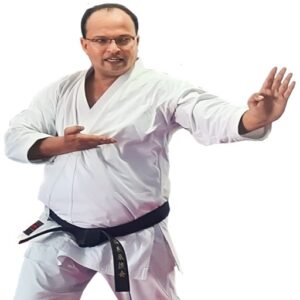
Section: Technical Insight Title: Philosophy Budo 武道
Philosophy Budo 武道
From very ancient times humans had to face and deal with danger because he was under constant attack from their environment, animals as well as other human beings. The struggle to survive in life made him invent methods of combat. These combat were armed and sometimes unarmed, the unarmed combat of offense and defense gradually evolved into the martial arts that we know today as fighting techniques. At first, they were crude attempts at hitting back but later came the first masters who gradually laid down a few rules of combat. These rules gradually become more sophisticated under the inspiration and experience of the masters. read more…..
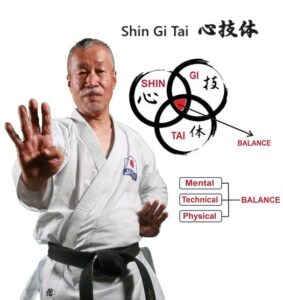
Section : Technical Insight Title: Shin Gi Tai 心技体
Shin Gi Tai 心技体
A proper balance of Shin Gi Tai turns an ordinary martial artist into an extraordinary martial artist | Sensei.
心Shin (mind, spirit, heart in Japanese Kokoro),
技Gi (skill, ability, art, technique waza in Japanese),
体Tai (physical, body karada in Japanese).
It is a common term used in Japanese martial arts practice. These 3 characters represent different aspects of martial arts training read more…..
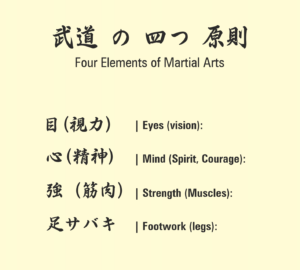
Section : Technical Insight Title: 武道 の 四つ 原則 | The Four Elements of Martial Art
武道 の 四つ 原則 | The Four Elements of Martial Arts.
The four essential elements of martial arts that also apply to Karate are as follows: –
目(視力) | Eyes (vision): Keep your eyes (vision) on your opponent and carefully observe your opponent’s movements first and instantly you have to analyze the surroundings e.g. the place, indoor or outdoor, weather, terrain, etc. The first move to win is to place yourself in an advantageous position before facing your opponent. read more…..
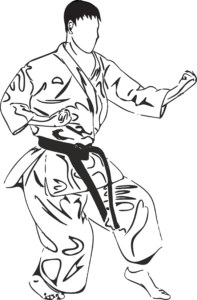
Section : Technical Insight Title: Tachikata たち 型
Tachikata たち 型 Kata is a Japanese term for stances and lower body positions. The basic requirements to improve one’s karate techniques are the correct body position and balance. Powerful, accurate, smooth, and fast techniques can only be delivered through stable and strong stances. One needs to maintain a firm and stable position to execute a strong technique but not be rigid, and one must be able to switch stances when required.
Stances can be categorized in three ways: high and one-leg stance, middle high and lower, and the way the foot and knees are used in aligning the center of gravity for stability. read more…..
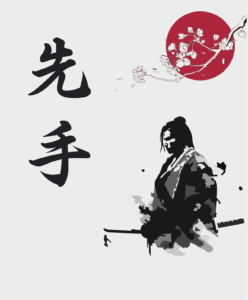
Section : Technical Insight Title: Sen-te (Initiatives) 先手
Sen-te (Initiatives)先手
In martial arts, the concept of “Sen-te (先手)” means “initiatives” taken to time one’s response during the time of combat. This strategy comes from the book of Five Rings by one of the greatest warriors of Japan Miyamoto Musashi.
In the Sen strategy, there are 3 types mentioned below: –
- Go No Sen 後の先 (defense and react with Offense)
- Sen No Sen 先の先 (defense with the attack- same time)
- Sen, Sen No Sen先先の先: (Anticipate your opponent’s attack and counterattack at the same time).
read more…..
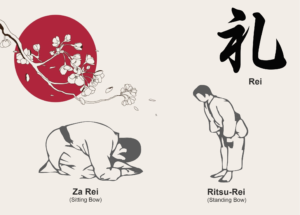
Section : Technical Insight Title: Reishiki 礼式 or Reigi 礼儀
Reishiki 礼式 or Reigi 礼儀
Rei comes from the Japanese word ‘Reigi’ which means ‘Respect, Courtesy, Manners’.
Rei (Bow) respect, etiquette, and manners are some of the most important and foremost required qualities from a person who wishes to learn Japanese martial arts.
read more…..

Section : Technical Insight Title: Dojukun 道場訓
Dojokun 道場訓
‘’Training Hall’’ rules are called Dojo kun (道場訓) in Japanese martial arts. Generally displayed at the entrance to a dojo or at the “front” (shomen) of the dojo, everyone should obey and follow it. Some schools of martial arts recite at the end of class. read more…..
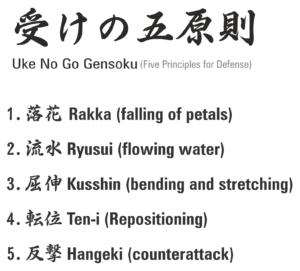
Section : Technical Insight Title: Uke No Go Gensoku 受けの五原則 | Five Principles for Defense
Uke No Go Gensoku 受けの五原則 | Five Principles for Defense
The Shito-Ryu karate system formalizes and emphasizes the five principles of defense, developed by Kenwa Mabuni, and known as Uke no go gensoku (受けの五原則):
- 落花 Rakka (falling of petals): Receiving the opponent’s attack with a strong counter-defensive technique by staying at the same place. The defensive technique should be so strong that if it were applied to the trunk of a tree then the tree would shed its leaves like falling petals.
g. You receive Chudan Tsuki at your set position with Yoko Uke or Yoko Uchi.
read more…..
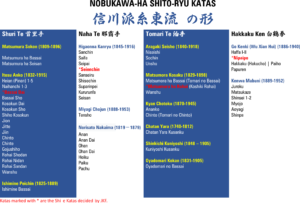
Section updated in: Technical Insight Title: Shito-Ryu Kata 型 or 形
Kata 型 or 形 is a Japanese term that means “form”. It consists of detailed choreographed patterns of martial arts techniques. It is a method to preserve and practice martial arts techniques passed from generation to generation. It is one of the best ways to memorize and perfect the movements. read more…
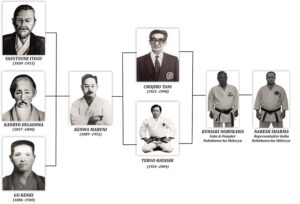
Section: Technical Insight Title: Genealogical-karate-chart-系図
Geneological Karate Chart 系図
The karate genealogical chart shows the flow of knowledge of martial arts passed through generations and proves the authenticity of the techniques and knowledge that are being passed to the next generation.
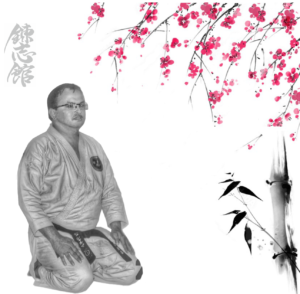
Section : Technical Insight Title: Sensei (Teacher) 先生
Sensei (Teacher) 先生
Sensei The relationship between a teacher and a student in martial arts is significant. In today’s modern world, this bond is weakening due to society’s rising misunderstanding and unhealthiness. In schools, the teachers are not allowed to physically interact with students as it was in the olden times, and the whole communication is verbal.
Karate-Do is a martial art and cannot be taught only by verbal communication and means. Karate-Do is a martial art and cannot be taught only by verbal communication and means. The Karate Teachers have to demonstrate the techniques themselves and the students must observe them. read more…..
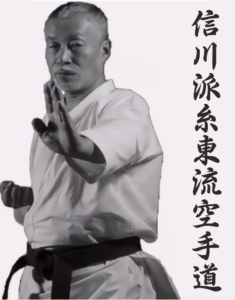
Section : Technical Insight Title: Nobukawa-ha Shitoryu History 信川派糸東流歴史
Nobukawa-ha Shito-Ryu 信川派糸東流歴史
Kuniaki Nobukawa at the age of 13 in the year 1960 started learning karatedo from a neighbouring young man, who was attending karate lessons. He was so engrossed in the art that he officially became a disciple of Chojiro Tani Sensei (direct discipline of Mabuni Kenwa – founder of Shitoryu). In 1974, at the age of 27, Nobukawa presided over Tani ha Shitoryu Seiku kai, Inami Branch.
In the year 1988, at the age of 41, Nobukawa withdrew membership for various reasons. At the same time of his withdrawal, Tani ha Shitoryu Seiku kai, Inami Branch was certified by Tani ha Shitoryu Syuko Kai as a direct control branch. read more…..
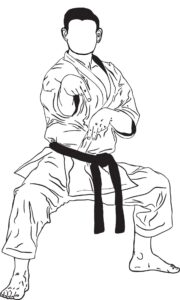
Section : Technical Insight Title: Shitoryu Karatedo History 糸東流歴史
Shito-Ryu Characteristics 糸東流 特徴 | 手法
Shitoryu Karate style integrated mainly 4 karate systems known as Shuri-Te, Naha-Te, Tomari-Te, Hakkaku Ken, and Ryukyu Kobujustu. All four karate systems have versatile fighting methods practiced in one karate style Shitoryu. A Shitoryu karate practitioner should understand and learn all the distinctive systems separately understanding their principles, and specialties without intermingling.
Shito-Ryu focuses on the dynamic use of long (Zenkutsu) and short (Moto) stances with linear non-telegraph moves which are extremely fast and powerful of Itosu-ha. It also uses dynamic tension breathing techniques (sanchin/tensho), circular moves (mawashi uke), and deep, lower stances (Shiko, Neko Ashi Dachi) of Higaonna-ha. Along with Shuri-Te, Naha-Te and Tomari-Te Shitoryu also focus on Hakkaku Ken (Crane’s fist) techniques derived from Chinese martial arts by Go-Kenki. read more….
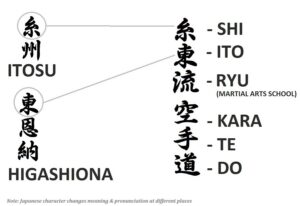
Section : Technical Insight Title: Shitoryu Karatedo History 糸東流歴史
Shito-Ryu History 糸東流歴史
Master Kenwa Mabuni the founder of the Karate-Do style “Shito-Ryu” was born on November 14, 1889, in Shuri, Okinawa, Japan. He belonged to the 17th generation of one of the bravest warriors of the Ryukyu kingdom Kenio Oshiro. In his childhood, Kenwa Mabuni was a physically weak child and so his family members encouraged him to be strong like their ancestors. Even Kenwa Mabuni dreamed of becoming physically strong and at the age of 13, he was accepted as a student at the dojo of the famous Karate-Do master Yasutsune Itosu (Nicknamed Ankoh), who lived in Shuri city of Ryukyu island Okinawa. Kenwa Mabuni trained sincerely every day which made him learn the art of Shuri-Te (Martial arts from Shuri City) within 7 years. read more….
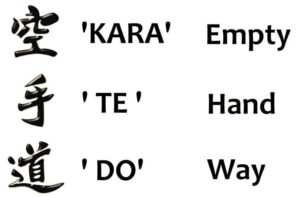
Section : Technical Insight Title: Karatedo 空手道
Karate-Do 空手道
The word Karate-Do 空手道 means ‘Kara’ Empty, ‘Te’ hands, and ‘Do’ signified the philosophical way. Indigenous Okinawa fighting art ‘TODE’ also had Chinese influence hence it was also called ‘Kara’ Chinese ‘Te’ Hands or ‘Chinese hands.
Master Gichin Funakoshi a student of Yasutsune Itosu travelled to mainland Japan from Okinawa to propagate and develop ‘Karate’ and thus represented the art for acceptance as a formal martial art in Japan’s leading government-sanctioned martial arts body read more…

Section : Technical Insight Title: Reishiki 礼式 or Reigi 礼儀
Reishiki 礼式 or Reigi 礼儀
Rei comes from the Japanese word ‘Reigi’ which means ‘Respect, Courtesy, Manners’.
Rei (Bow) respect, etiquette, and manners are some of the most important and foremost required qualities from a person who wishes to learn Japanese martial arts.
read more…..







